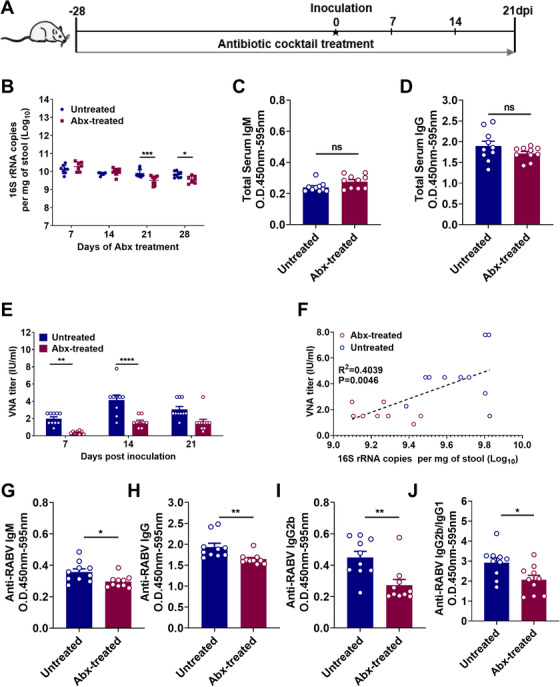FIGURE 1.

Gut microbiome is indispensable for optimal RABV‐specific antibody production. A, Schematic of treatment regimens. Female ICR mice, 3‐week‐old, (n = 10) were fed with a cocktail of antibiotic (Abx) treatment through drinking water for 28 days prior to vaccination and continuously throughout the experiment to deplete gut microbiome, or administrated with sterile water as negative control. The feces of Abx‐treated mice and untreated mice were collected weekly before vaccination for fecal DNA extraction and quantification. (Untreated mice, n = 10, Abx‐treated mice, n = 10). B, Bacteria in stool samples, collected at the indicated times, were quantified by qPCR. Error bars in the graphs represent standard error (* P < 0.05; *** P < 0.001; Student's t‐test). C,D, IgM and IgG in serum of mice was measured by ELISA after 28 days of Abx treatment. E, The Abx‐treated mice and untreated mice were i.m. inoculated with 107 FFU rabies vaccine strain iLBNSE in the hind limbs. At indicated times, serum samples were collected for measurement of RABV‐specific VNA titers. F, Pair‐wise analysis of bacterial levels in stool vs RABV‐specific VNA titers at 14 days post inoculation. G‐J, Anti‐RABV IgM, IgG, IgG2b, and the IgG2b/IgG1 ratio were measured by indirect ELISA, and antibody levels in untreated mice were significantly higher than in Abx‐treated mice. Error bars in the graphs represent standard error (* P < .05; ** P < .01; Student's t‐test)
